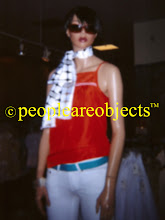I was living in Astoria, Queens in a two-bedroom first floor converted studio that was part of a six-unit walk-up. I turned one of the bedrooms into a design studio where I kept a large pattern table I constructed myself out of scrap wood from a local yard. If they didn't have to cut it, it would be free. The piece of plywood that would become the table top was so large, and I was without a car, that the lumber yard allowed me to take one of their rolling racks in order to get it home. I rolled the rack down seven blocks of Astoria Boulevard.
Errors and Omissions:
In the last paragraph I stated that I had a table I "constructed myself". The truth is that I constructed it with the help of my girlfriend at the time. She, too, accompanied me on the harrowing trip along Astoria BLVD. with the rusted-out rolling rack and the huge plywood slab. She owned a beautiful Makita cordless drill with full set of bits.
She was a fashion designer, living in Chelsea, working for **** ******. Out of respect for her privacy, I will not describe her further. She would be my first post-High School girlfriend. It would last only a few months. I was 23 years old.
.....................
The summer came and the humidity arrived, and the work dried up.

I found myself with only one client through the whole of summer; a junior wear line that had me knocking off H&M samples for them. I did their first through production patterns, sample fittings, and some technical packages. I did all the work by hand.
Patternmaking is something I always enjoyed and it's the one part of fashion design I still reserve the most respect for to this day. At this time, 2000 specifically, a good amount of patternmaking was still being done in-house domestically in New York City, and one could find freelance work fairly easily if one were not afraid to cold-call. Many small companies, such as the aforementioned junior wear line above, would use freelance patternmakers and technical designers exclusively. It was much more-cost effective to pay a freelancer by the piece than to have an in-house patternmaker there 50 hours a week. Most companies paid under the table, so books were kept clean, and everyone was happy.

The key to being a successful patternmaker is being fast and accurate. Deadlines are not negotiable and missing them is the best way to find yourself out of work. The phone just stops ringing. Most patterns are knock-offs and most designers work in simple silhouettes, since these are easier and, more importantly, faster for factory sewers to run-up. This means you don't have to be the best patternmaker your school produced, just a decent, competent one who understands fit, delivers clean understandable patterns, and delivers them on time.
This process differs from knitwear in that often I would be working with tangible garments. I made the first pattern based on a pair of jeans or a shirt from H&M or Strawberry or XOXO. This pattern would be made on white "dot" paper which is broad drafting paper slightly thicker than tracing paper. A sample garment would be cut out of this pattern and sewn up. Depending on the company this happened in the studio in New York or the pattern was mailed to India or China, along with the sample fabric, and the sample would be run up there and shipped back. The sample garment would be fit on the in-house fit model and I would make corrections accordingly. If the corrections were minor, the next pattern would often be the final production pattern, and this I would cut out of a heavy card stock. This final pattern would be sent off to the factory, along with technical drawings, spec sheets, and sizin
or XOXO. This pattern would be made on white "dot" paper which is broad drafting paper slightly thicker than tracing paper. A sample garment would be cut out of this pattern and sewn up. Depending on the company this happened in the studio in New York or the pattern was mailed to India or China, along with the sample fabric, and the sample would be run up there and shipped back. The sample garment would be fit on the in-house fit model and I would make corrections accordingly. If the corrections were minor, the next pattern would often be the final production pattern, and this I would cut out of a heavy card stock. This final pattern would be sent off to the factory, along with technical drawings, spec sheets, and sizin g rules, and various pattern layouts would be made. These are large grids the width of the fabric on which the pattern pieces are laid out like a puzzle in order to maximize fabric efficiency and keep waste to a minimum. From these thousands of garments are cut, sewn, tagged, bagged, and packed onto shipping containers bound for US ports. Eventually, they make there way to a rickety metal rounder or four-way rack in a retail store near you.
g rules, and various pattern layouts would be made. These are large grids the width of the fabric on which the pattern pieces are laid out like a puzzle in order to maximize fabric efficiency and keep waste to a minimum. From these thousands of garments are cut, sewn, tagged, bagged, and packed onto shipping containers bound for US ports. Eventually, they make there way to a rickety metal rounder or four-way rack in a retail store near you.
 or XOXO. This pattern would be made on white "dot" paper which is broad drafting paper slightly thicker than tracing paper. A sample garment would be cut out of this pattern and sewn up. Depending on the company this happened in the studio in New York or the pattern was mailed to India or China, along with the sample fabric, and the sample would be run up there and shipped back. The sample garment would be fit on the in-house fit model and I would make corrections accordingly. If the corrections were minor, the next pattern would often be the final production pattern, and this I would cut out of a heavy card stock. This final pattern would be sent off to the factory, along with technical drawings, spec sheets, and sizin
or XOXO. This pattern would be made on white "dot" paper which is broad drafting paper slightly thicker than tracing paper. A sample garment would be cut out of this pattern and sewn up. Depending on the company this happened in the studio in New York or the pattern was mailed to India or China, along with the sample fabric, and the sample would be run up there and shipped back. The sample garment would be fit on the in-house fit model and I would make corrections accordingly. If the corrections were minor, the next pattern would often be the final production pattern, and this I would cut out of a heavy card stock. This final pattern would be sent off to the factory, along with technical drawings, spec sheets, and sizin g rules, and various pattern layouts would be made. These are large grids the width of the fabric on which the pattern pieces are laid out like a puzzle in order to maximize fabric efficiency and keep waste to a minimum. From these thousands of garments are cut, sewn, tagged, bagged, and packed onto shipping containers bound for US ports. Eventually, they make there way to a rickety metal rounder or four-way rack in a retail store near you.
g rules, and various pattern layouts would be made. These are large grids the width of the fabric on which the pattern pieces are laid out like a puzzle in order to maximize fabric efficiency and keep waste to a minimum. From these thousands of garments are cut, sewn, tagged, bagged, and packed onto shipping containers bound for US ports. Eventually, they make there way to a rickety metal rounder or four-way rack in a retail store near you. ................................
Near the end of the summer I had to take temporary office jobs to keep on top of rent and bills. I also broke down and started looking for a roommate. I took the pattern table out of the spare room and installed it in my bedroom. I kept my futon mattress folded under the table during the day, and I slept under the table at night.
I owned:
One futon mattress
One makeshift studio table
Two tall blue-glass drinking glasses (a housewarming gift from the ex-girlfriend)
A blue Casio digital wrist-watch (a birthday gift from the ex-girlfriend)
One large suitcase of clothing
One television set
Assorted patternmaking tools
One electric fan
The summer came and the humidity arrived, and the work dried up, and I was all alone.
Near the end of the summer I had to take temporary office jobs to keep on top of rent and bills. I also broke down and started looking for a roommate. I took the pattern table out of the spare room and installed it in my bedroom. I kept my futon mattress folded under the table during the day, and I slept under the table at night.
I owned:
One futon mattress
One makeshift studio table
Two tall blue-glass drinking glasses (a housewarming gift from the ex-girlfriend)
A blue Casio digital wrist-watch (a birthday gift from the ex-girlfriend)
One large suitcase of clothing
One television set
Assorted patternmaking tools
One electric fan
The summer came and the humidity arrived, and the work dried up, and I was all alone.
...........................










No comments:
Post a Comment